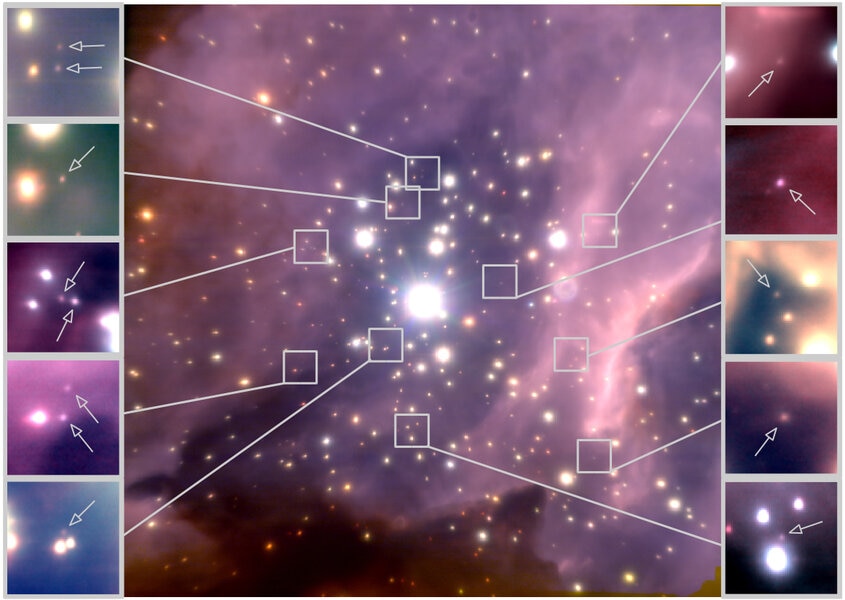Create a free profile to get unlimited access to exclusive videos, sweepstakes, and more!
100 billion brown dwarfs lurk in the galaxy

I recently wrote about citizen scientists (people who are enthusiastic about science but who may not have professional scientific training) combing through NASA data and hitting pay dirt: They found a brown dwarf just a little over a hundred light-years away, one that had been missed by previous data searches.
It turns out there may be a lot more to find. And by a lot more, I mean A LOT MORE. Scientists have recently found that there could be as many as one hundred billion brown dwarfs in our galaxy, half as many as there are stars!
Brown dwarfs are funny objects. They’re more massive than planets, but lack the mass needed to squeeze hydrogen in their cores hard enough to get it to fuse into helium. That’s what makes a star a star: the ability to stably fuse one element into another. The definitions get complicated, because nature isn’t as fussy about having clear boundaries between one type of object from another as humans are, but in the end brown dwarfs occupy that space between planets and stars, similar to but distinct from both.
They’re their own thing. And we didn’t even know they existed until 1995, when the first, Teide 1, was discovered. They’re incredibly faint in visible light (the kind of light we see), and even in infrared, where they give off most of their energy, they’re not exactly beacons. But they started turning up in observations made by telescopes equipped to look in the infrared, and now we know of a few thousand.
The thing is, the ones we see are perforce nearby. More than a thousand light-years away or so, they fade to invisibility. That may seem like a lot, but the Milky Way galaxy is one hundred thousand light-years across! We’re only seeing brown dwarfs locally, so it’s hard to get good statistics on them galactically.
But there’s a way around that. The thing to do is look where you know there should be some ... like, say, a star cluster. These are groups of hundreds or thousands of stars, all bound together by their own gravity. Typically, the stars were all born around the same time from a cloud of gas, and that’s a huge advantage: As stars age they change color, and so by measuring their colors you can get the age of the cluster.
That’s important, because the same thing happens with young brown dwarfs, too. Their color depends on their mass — a more massive object is hotter, which makes it bluer— so if you know the color and age of a brown dwarf, you can determine its mass*. That helps you distinguish it from a planet or a star.
And a team of astronomers did just that. They looked at several star clusters that were close enough to Earth that brown dwarfs are visible. Then they basically counted up what they saw, measured the colors, and figured out how many of the objects were stars and how many were brown dwarfs.
What they found was that about half the objects in the clusters were brown dwarfs. Extrapolating that to the galaxy at large, there could be 25 – 100 billion such objects in the Milky Way galaxy alone.
This conclusion was already hinted at by previous stellar cluster surveys, but this one found that the result stayed the same across a variety of different cluster types. Some had more stars packed more tightly in them (which can affect how stars are born), and some had a lot of very massive stars, which can also affect the environment around them.
None of this appears to matter. Clusters make about two stars for every brown dwarf. And that means that our galaxy is littered with them.
This makes me very happy. I really like brown dwarfs; they’re fascinating objects and, once upon a time, I worked on Hubble observations of one of the two first brown dwarfs ever discovered, Gliese 229B. It was fascinating to see the spectra, revealing the presence of things like cesium and water vapor in its atmosphere. Water vapor: steam! I was used to observing stars and other very hot objects, so to find something as mundane as good old water in Gliese 229B was truly weird to me at the time.
Also, much like planets orbiting other stars, we had suspected the existence of brown dwarfs for decades, but they were maddeningly elusive. Then, once one was found, more started showing up. Once we knew they were out there, and the best way to look for them, we started finding hundreds of them. Thousands.
This is such a wonderful allegory. We look up at the night sky and try to imagine what’s out there, and what we find out is that there are wonders beyond what we would have thought even a few years ago! And not just a few, but billions, hundreds of billions of new things to discover.
The more we look, the more we let our curiosity drive us, the more there is to find. That’s one of my favorite things about our Universe.
*As with everything in science, it’s actually more complicated than this. You actually have to measure the brown dwarf’s spectrum, basically dividing its light into hundreds or thousands of very narrow color ranges. Even then it’s a bit tricky. But that’s the idea.



























